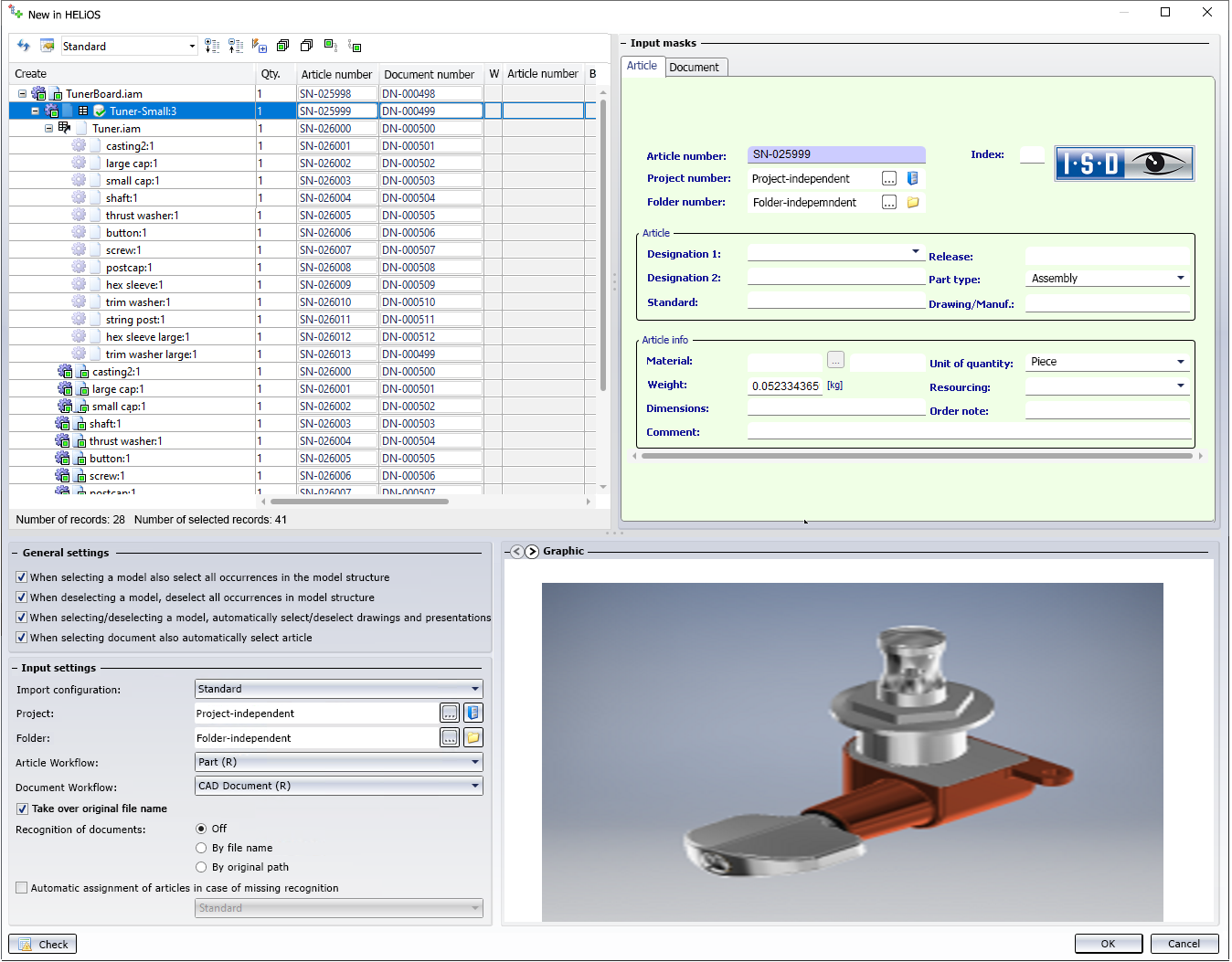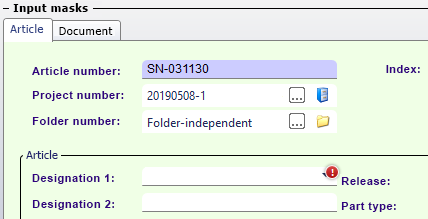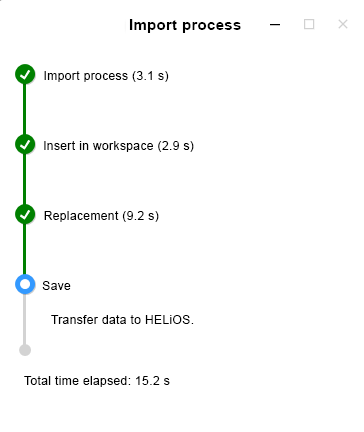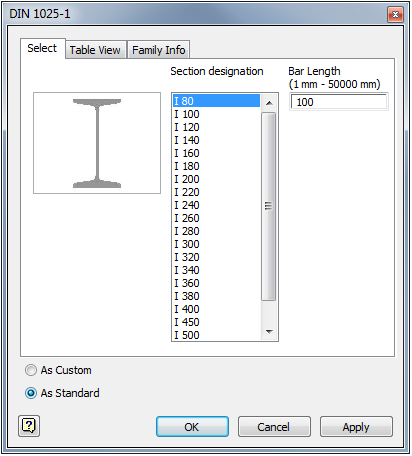New in HELiOS
Input > New in HELiOS 
In the Data function group you can choose the New in HELiOS  function to call a dialogue window for the transfer of CAD model structures to the HELiOS database.
function to call a dialogue window for the transfer of CAD model structures to the HELiOS database.
![]() Please note:
Please note:
You can also find the function on the Ribbon tab for the Active part. From there you can carry out the derivation for the active part (rather than for the complete drawing).

Create
In the structure tree beneath Create you can see the model structure:
The top part shows (depending on the Inventor version) the Inventor file name or a different designation; sub-assemblies are indicated with their HELiOS article number.
Associated drawing documents are marked with this symbol: 
If identical parts or assemblies occur multiple times in the model drawing, these multiple occurrences will be automatically activated if you choose one of them in the structure.
You can exclude individual elements of the model drawing from a transfer by deactivating their checkboxes.
Special dependencies between parts are marked as follows:
-
 indicates dependent parts.
indicates dependent parts. -
 indicated parameter references.
indicated parameter references. -
 indicates 3rd party references.
indicates 3rd party references. -
 indicates a configuration generated from an iPart/iAssembly. The associated Factory, too, is indicated beneath it, too, with a
indicates a configuration generated from an iPart/iAssembly. The associated Factory, too, is indicated beneath it, too, with a  symbol.
symbol. - Standard parts which have not been integrated via Inventor Content Center and whose Family and MemberID cannot be transferred to the HELiOS article master are marked with a
 symbol.
symbol. -
 indicates a substitution geometry. Please also read the information given in the relevant topic.
indicates a substitution geometry. Please also read the information given in the relevant topic. -
 indicates an automatically recognized and assigned article.
indicates an automatically recognized and assigned article.
![]() Important:
Important:
The original documents will not be changed by the New in HELiOS in the process, unless an original document is not transferred while subordinated documents are checkmarked for transfer. In such a case, the references will also be exchanged for the superordinate document. This scenario, however, makes only sense in a context where the same user want to successively transfer a complete structure to HELiOS, since an assembly that has been changed in this way can no longer be loaded on other workstations (as the references to the documents that have been transferred to HELiOS would be missing).
At the top of the window you find the following options:
-
Click
 and
and  to expand or collapse all levels of the entire structure.
to expand or collapse all levels of the entire structure. -
 Select all selects all elements of the structure,
Select all selects all elements of the structure,  Deselect all removes all selections again.
Deselect all removes all selections again. -
 Select all documents makes it possible to select only newly added documents with one click, if under General settings the option When selecting document also automatically select article has been deactivated.
Select all documents makes it possible to select only newly added documents with one click, if under General settings the option When selecting document also automatically select article has been deactivated. -
Click
 Do not automatically (de)select complete substructure upon (de)selection if you want to select or deselect only one particular element of the structure, and not its entire sub-structure together with it. Click once more on
Do not automatically (de)select complete substructure upon (de)selection if you want to select or deselect only one particular element of the structure, and not its entire sub-structure together with it. Click once more on  Automatically (de)select complete substructure upon (de)selection, if you also want to select or deselect the sub-structure of the selected element.
Automatically (de)select complete substructure upon (de)selection, if you also want to select or deselect the sub-structure of the selected element. -
Click
 if you do not want superordinate models of the selected element to be checkmarked automatically. Please note that in some cases this dependency cannot be broken up; for instance, superordinate levels of released models must always be selected, too (this selection will happen automatically). Clicking
if you do not want superordinate models of the selected element to be checkmarked automatically. Please note that in some cases this dependency cannot be broken up; for instance, superordinate levels of released models must always be selected, too (this selection will happen automatically). Clicking  resets the option to the mode that automatically selects superordinate models when selecting an element in the structure.
resets the option to the mode that automatically selects superordinate models when selecting an element in the structure.
General settings
|
When selecting a model also select all occurrences in the model structure |
If this checkbox is active, each additional occurrence in the model structure is automatically selected for the generation of the HELiOS data when clicking on a part or an assembly that has been inserted several times in the model drawing. If the option is deactivated, multiple models can also be saved individually. If the option When deselecting a model, deselect all occurrences in the model structure (see below) is inactive, it only has an effect on the selection and not on the deselection, i.e. you can use the option to select all occurrences with one click and then have the option to selectively deselect individual occurrences again. |
|
When deselecting a model, deselect all occurrences in the model structure |
This setting has the same effect as When selecting a model also select all occurrences in the model structure (see above) also when (re)selecting elements of the model structure. |
|
When selecting/deselecting a model, automatically select/deselect drawings and presentations |
With this checkbox you can determine whether drawings and/or presentations linked to a model are automatically selected or deselected in the dialogue when selecting or deselecting the model (active by default). |
| When selecting document also automatically select article |
If this option is set, the corresponding article is automatically selected when a document is selected. If you do not create article masters for all document masters, you should deactivate the checkbox. If you use the option Select all documents under Create, the "missing" article masters will not be subsequently ticked during the successive transfer of legacy data data for sub-assemblies that have already been transferred and contain parts without article masters. |
Input settings
Beneath Input settings you can choose an Import configuration for the attribute mapping of the database transfer from the pull-down menu (if several configurations have been created). Furthermore, you can specify a Project, Folder, Article Workflow and Document Workflow. Further down you find options for the Recognition of already transferred documents.
If you activate the Take over original file name checkbox, the file name of the CAD model drawing will be taken over into the HELiOS database.
![]() Important:
Important:
This makes only sense if unique file names have always been used. If file names occur multiple times, a search for documents in the database according to file name will, of course, make little sense.
Further down you can find options for Recognition of already taken over documents:

 For iParts/iAssemblies, this option also ensures that their folder structure is transferred to the HELiOS Workspace.
For iParts/iAssemblies, this option also ensures that their folder structure is transferred to the HELiOS Workspace.
If Recognition of documents has been set to Off, parts can be re-entered in HELiOS, i.e. the same assembly can be entered multiple times. If you do not want this, you have the following two options:
- By file name: Each document to be transferred will first by searched in HELiOS. If a HELiOS document with the same file name is found, the document will not be transferred, but the one that already exists in the database will be reused.
 In this context the Take over original file name option plays an important role, since it ensures that no "cryptic" file name will be generated by HELiOS. Only then can documents be recognized by the file name with the help of this option.
In this context the Take over original file name option plays an important role, since it ensures that no "cryptic" file name will be generated by HELiOS. Only then can documents be recognized by the file name with the help of this option.
- By original path: During data transfer, HELiOS saves the (complete) original file path. If this option has been activated, the system searches for documents in HELiOS for which this original path has been set.
A recognition By file name makes sense if you want to transfer old data in a local directory, e.g. because they were stored there by a CAD designer for a later transfer. For a successive data transfer from a central directory (e.g. on a Server), in contrast, the recognition by original path would be the preferred option.
Below that you can activate the option Automatic assignment of articles in case of missing recognition.

If additional user-defined attribute mappings have been created for the automatic article assignment, you can select thesev in the pull-down menu (with the default entry Standard).
Input masks
In the upper right corner of the Input masks area, you can see the corresponding master data details for the active Article or Document, as you are used to from the HELiOS input or detail masks.
If, when attempting to enter data via the dialogue, there are incorrect input fields such as missing mandatory attributes, the corresponding field in the mask area is marked with an exclamation mark.

Graphic
In the Graphic preview at the bottom right of the dialogue window, the currently marked document in the model structure is shown. If the top part is active, you will see a graphic of the entire model drawing or HELiOS assembly; if you clicked any sub-assemblies or individual parts, only these will be shown in the Graphic window.
Check
Use the Check button at the bottom left to perform a check for completeness or consistency. If mandatory inputs are still missing, an error message referring to the affected documents and/or articles will be displayed (this will also happen if you click the OK button while inputs are missing).
After saving the model structure in HELiOS, the original model drawing will be closed, and you will continue your work in the HELiOS document.
Progress display
After executing the input dialogue with OK, a progress display gives you further information about the stages the process goes through: object creation in HELiOS, insertion into the HELiOS workspace, replacement of local data and references in the CAD system with the corresponding HELiOS information and a final saving process.

If problems occur and the process cannot be carried out to the end, you will see corresponding error messages afterwards.
Further notes
Referenced models
If you work with referenced models, you have the option to influence the selecting/deselecting behaviour through referencing of associated models via the When selecting a referenced model also select superordinate model checkbox beneath General settings.
References of geometries in Inventor that have been placed via imports from other CAD systems cannot be edited after their transfer to HELiOS, as the Inventor APIs do not allow access to them.
Linked drawings
If a drawing is found for an assembly or a part, its transfer to the database as a linked HELiOS document will be offered.
A prerequisite for this is that the drawing is located in the same directory as the part or the assembly, and that it has the same file name preceding the file extension.
However, the file name preceding the extension needs not necessarily be identical (Example: The drawing "MyAssembly.idw" belongs to the same-named assembly "MyAssembly.iam"), but linked drawings will also be recognized if they begin with the same name as the corresponding part, e.g. if the file names of the drawings are composed of a particular file name, plus an additional number: For instance, for an Inventor part called "InventorPart.ipt" the drawing "InventorPart-01.idw" will be found and assigned accordingly.
 You have the option to define a fixed suffix value in the Registry at HKEY_LOCAL_MACHINE\Software\ISD Software und Systeme\Inventor\DrawingNameSuffix. In this way, each drawing file with this suffix will be assigned to an .iam- or .ipt file which has the same file name minus the suffix. Example: If "-03" has been defined as fixed suffix in the Registry, a drawing file for the assembly "MyAssembly.iam" would then be called "MyAssembly-03.idw", and a corresponding link would be established.
You have the option to define a fixed suffix value in the Registry at HKEY_LOCAL_MACHINE\Software\ISD Software und Systeme\Inventor\DrawingNameSuffix. In this way, each drawing file with this suffix will be assigned to an .iam- or .ipt file which has the same file name minus the suffix. Example: If "-03" has been defined as fixed suffix in the Registry, a drawing file for the assembly "MyAssembly.iam" would then be called "MyAssembly-03.idw", and a corresponding link would be established.
 When saving drawings, please also note that Inventor will mark the contained models as "locally changed". HELiOS will recognize that the change of the previously unchanged models was caused by the takeover of the drawings, and will carry out an automatic saving of the corresponding models. However, no saving will take place if models have already been locally changed before the taking over of the associated drawing.
When saving drawings, please also note that Inventor will mark the contained models as "locally changed". HELiOS will recognize that the change of the previously unchanged models was caused by the takeover of the drawings, and will carry out an automatic saving of the corresponding models. However, no saving will take place if models have already been locally changed before the taking over of the associated drawing.
Standard Parts from the Inventor Content Centre
If Beam Standard Parts (or semi-finished products) are transferred from the Inventor Content Centre to HELiOS, one part master per beam type will be created, and further sub-types (with different usage attributes) of the type will be automatically assigned to it upon saving.
The recognition of the standard part ID takes place via the document master.
For beams from the Inventor Content Centre which have been set to "As Custom" in the model drawing (and not to "As Standard") own article masters will be created.
Standard parts that are already known in HELiOS will be automatically entered into the product structure or model structure, respectively, upon saving. Parts that are not known in HELiOS yet must be selected with New in HELiOS and entered manually.

The saving of the standard parts as HELiOS documents allows a complete export of assemblies including standard parts on systems where HELiOS has not been interfaced with Inventor.
While the Content Center remains the source of the standard parts, the management of permission takes place via HELiOS.
It makes sense to use the option As Standard, to ensure that multiple occurrences of a standard part obtain the same article master.
Generally, if there are multiple document masters for one standard part article, it is always the current Standard Part representation that is defined as document master and exists in the model drawing.
For Standard Parts in conjunction with replacement geometries the following applies: Document masters which are marked as replacement documents, will be ignored during the article synchronization of the Standard part ID.
In addition to the recognition of the semi-finished product, the length of the semi-finished product is also recognised so that the creation of a new semi-finished product document with exactly the same length will be prevented.
For how standard parts inserted As Custom, you can set in the HELiOS Options that the corresponding semi-finished products are transferred to the product structure as sub-items.
 However, please note the following:
However, please note the following:
If standard parts have not been placed/incorporated directly via the Content Center, for example because they are parts from data transfers, it is not ensured that the recognition by HELiOS takes place via the document master. If, for example, Content Centers are merged, it can happen that different files in the content center path have the same internal part identifier. In this case, you must ensure yourself that two components with the same standard part identifier cannot be interactively installed. This means that files that are not interactively built from the Content Center must not be rebuilt manually (e.g. by Drag & Drop) in the future.
An automatic replacement process exists for standard parts when saving. The reference to the Content Center file is exchanged with the reference to the file from the HELiOS Workspace. Only standard parts that can be installed interactively are actually replaced.
If document masters exist in HELiOS for several of these files, it must be ensured that the correct standard part identifier is only stored for one document (the one that can also be installed interactively). The ISD Group normally ensures this in the context of data transfers.
Notes on iLogic
If you work with iLogic parameters, activate the required Registry key to ensure that the HELiOS designation of the new document that will be created during transfer to the PDM database (or during derivation) will also be applied in the iLogic tool.
To do this, open the Windows Registry, go to Computer\HKEY_CURRENT_USER\Software\ISD Software und Systeme\HELiOS Desktop\Settings, and set the key InventorILogicRuleAdjustment from 0 to 1.
Notes on sharing from the Diaphragm/Compression Spring Generator in Inventor
Cup springs from the diaphragm/compression spring generator cannot be managed in HELiOS due to the following restrictions: Corresponding parts of the spring generators are inserted as completely normal parts of the plate and are not specially classified, since apart from geometric features no data for recognition is available that can be taken into account in the document master.

